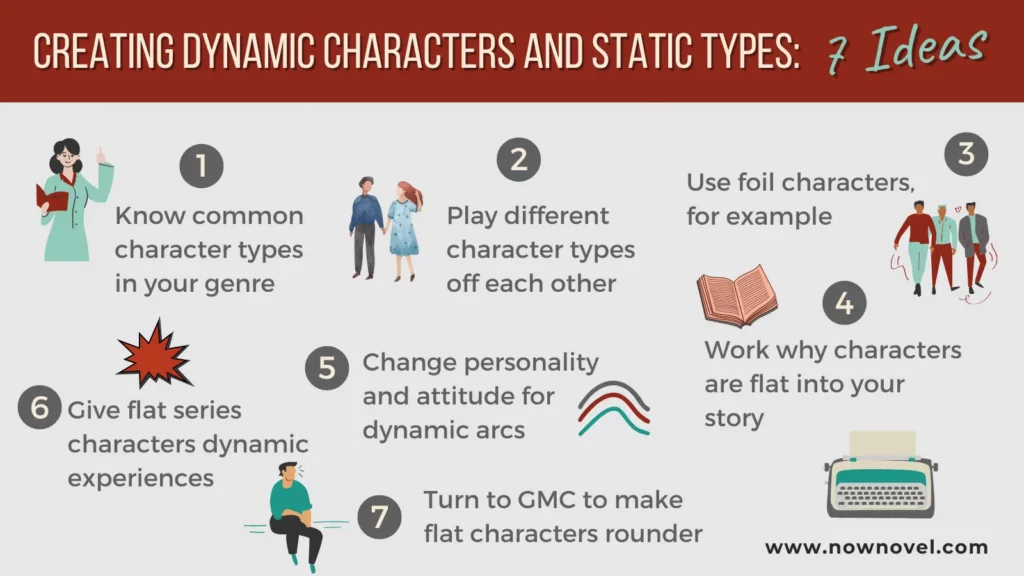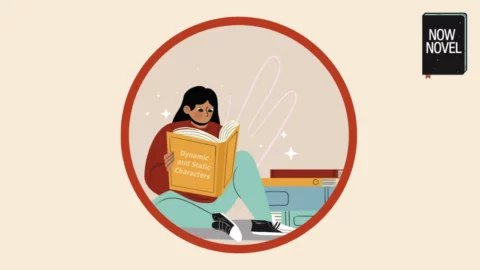Dynamic characters change while static characters tend to stay the same. Learn more about these character types, with examples:
Dynamic characters vs static characters: Definitions
A dynamic or round character in fiction has an arc involving significant growth or change.
A dynamic character may change in:
– Personality
– Beliefs or world view
– Ability or position
– Goals, desires and motivations
Pip in Charles Dickens’ classic Great Expectations (1861) is an example of this type. He goes from a poor orphan to a ‘man about town’ with money due to a mysterious wealthy benefactor.
The reader sees Pip grow from boyhood to adulthood, and as his financial circumstances change, so does his persona in subtle ways.
A static or flat character, by comparison, does not undergo significant inner change over an individual story or series.
For example, James Bond in the Ian Fleming novels and Bond films does not change much. He orders the same martini (‘shaken, not stirred’), romances similar femme fatale or ‘damsel in distress’ types.
Often, like Bond, the static or flat character serves a set purpose and function (for example, being an everyman assassin or a dependable sleuth like Sir Arthur Conan Doyle’s Sherlock Holmes).
A dynamic character is not necessarily better than a static character. Or as Lyman Baker of Kansas State University puts it:
The question […] is whether a portrayal is what is called for in light of the work as a whole, and whether it is done skillfully or ineptly, interestingly or boringly. (Indeed, even a persistent bore can be portrayed in an interesting — for example, quite comic — fashion.)
Lyman Baker, ‘Critical Concepts: “Static” and “Dynamic” characterization’, 2000.
For more on the role of static or flat characters, refer to our guide.
How to use dynamic and static characters
Seven tips to use dynamic characters and static character types well in your story:
- Know character types common to your genre
Which character types in your genre tend to be dynamic characters, and which tend to be static?
- Play different character types off one another
For example, in comedies the eccentric protagonist often is accompanied by a more straight-laced companion.
- Use static foil characters for contrasts
A character who enhances another through their contrasts is known as a ‘foil’. This comes from the phrase meaning to back a gem in jewelry with a foil, metal that makes the gem shine more brightly.
- Work why characters are flat into your story
Give characters a reason to be flat (for example, often a killer-for-hire is portrayed as having some brutalizing trauma in their past).
- Change personality and attitude for dynamic arcs
To write more dynamic, three-dimensional protagonists, think of subtle or overt ways their personality or attitudes might change.
- Give flat series characters dynamic experiences
In a series with flat main characters, change often comes from new locations, interesting walk-ons – for example, memorable villains and their hairless cats.
- Turn to GMC to make static characters dynamic
If a character feels flat (and you don’t want them to be the Bond type), turn to goal, motivation and conflict. What does your character want, why do they want it, and what opposition (external or internal) will test their resolve?
Let’s explore each of the above ideas further:
Know character types common to your genre
Each genre has characters who tend to be more dynamic and those who tend to be static
For example, in a romance story, the love interests typically undergo personal change. Said change is vital for attraction to build. Or for characters to (for example) let go of past disappointment and finally risk love again.
A flatter character type within romance, such as a rival for a lover’s affections, might not necessarily be as developed.
The flatter type serves a specific narrative function. For example, to make it uncertain whether love will win (more tension, suspense).
Study books that are selling well in your genre. Which characters are dynamic? Which are more static or flatter and why?
What narrative purpose do these characters have? (Do they add tension, or help main characters achieve their goals?).
Read our complete guide to character creation for more on character types and characterization resources.

Play different character types off one another
Few stories have just one type – static or dynamic characters. Memorable ensembles often have stark contrasts.
Take straight-laced reporter Tintin and his foul-mouthed friend, Captain Haddock. Cunning, tiny hero Asterix and his mentally less agile (but physically strong) friend, Obelix.
Try playing characters’ differences off one another.
Take an academic fantasy, for example. There may be teachers who keep helpful or mean personas even as your protagonist grows from a novice to adept.
Mixing dynamic and static characters is necessary in some ways. In an 80,000-word novel, there is not always space to explore every character’s personality. Each player’s goals, motivations and conflicts, in acute detail.
Develop Your Story’s Cast
Get character outlining tools, plus weekly feedback from editors and live webinars with writing coaches when you upgrade.
DEVELOP YOUR STORY
Use foil characters for contrasts
The reason for a foil (a metal backing for a gemstone) is to make the featured gem dazzle more. Throwing detail into relief through contrast is a technique shared by jewelers and authors.
What is a foil character?
Foil characters draw out other characters’ attributes (and often provide humor) through the ways they contrast.
Take the long-running sitcom Frasier, for example, a spinoff of the sitcom Cheers, about a radio therapist living in Seattle.
The pompous, narcissistic title character has a foil in his co-host, Roz. Where Frasier talks in circles, Roz speaks plainly. Where Frasier imagines events revolve around him, Roz dashes his pride with sarcasm.
Because the characters contrast so well, the audience anticipates each’s reaction to the other. There is inherent drama and comedy to this dynamic between opposites. Similarly, Frasier’s father who lives with him, an ex-cop with homely tastes, is constantly at odds with his ‘highfalutin’ son.
Why include a foil character?
A foil character may be more static than a protagonist while providing reaction or commentary (like Roz’s commentary on Frasier’s follies).
An example:
Famous foils: Sancho Panza in Don Quixote
Miguel de Cervantes’ Don Quixote is regarded as one of the earliest novels, published in two parts 1605 and 1615.
Alonso Quijano, a member of the lower nobility, reads so many chivalric romances he imagines he is a knight. Spurred by his imagination, Quijano names himself ‘Don Quixote de la Mancha’. Together with his aged, exhausted horse (who he reimagines as a valiant steed), he goes adventuring.
The foil character in the story is a down-to-earth farmer, Sancho Panza, whom the Don recruits as his ‘squire’.
Throughout the story, Sancho Panza comments wryly on the Don’s wild antics. Take the beginning of Chapter 8, where the Don is about to attack windmills he claims are giants:
“What giants?” said Sancho Panza.
Miguel de Cervantes, Don Quixote (translated by Edith Grossman), p. 58.
“Those you see over there,” replied his master, “with the long arms; sometimes they are almost two leagues long.”
“Look, your grace,” Sancho responded, “those things that appear over there aren’t giants but windmills, and what looks like their arms are the sails that are turned by the wind and make the grindstone move.”
“It seems clear to me,” replied Don Quixote, “that thou art not well-versed in the matter of adventures: these are giants; and if thou art afraid, move aside and start to pray whilst I enter with them in fierce and unequal combat.”
Through Sancho Panza, the reader sees the same scene from the Don’s crazed perspective and an ordinary farmer’s POV. The double vision of protagonist and his sidekick foil creates much of the story’s wry humor.
Work why characters are flat into your story
If you have flat characters, this two-dimensional quality should be intentional.
For some of Marvel’s Spiderman series, the figure of the superhero’s aunt, Aunt May, fulfils a more static archetypal ‘helper’ role. Part of the reason for this is that May does not know Spiderman as a hero. She only knows his alter ego Peter Parker, her geeky nephew.
The aunt figure does not have to get involved in the heroics. Her presence provides smaller moments of narrative tension though (for example when the hero is nearly unmasked) or aid.
To put the above differently, flat characters are flat because it serves the story’s focus.
Walk-ons and bit parts fulfil specific narrative functions that revolve around primary characters’ desires and fears.
This does not mean that a walk-on or bit part can’t upstage the main character at times. They might get a sub-story of their own (or even a spinoff).
Change personality and attitude for dynamic arcs
Dynamic characters change in personality and/or attitude. There is meaningful inner change prompted by the events of the story.
A bully might show dawning horror or sorrow as they realize the way their actions impacted others, for example. A person whose romantic advances are spurned might become more bitter and closed to love.
Lyman suggests helpful questions to interpret dynamic characters and the ways they change over the course of a story:
- What, exactly, is the change an author indicates has occurred?
- How might the reader understand the motivation or cause leading to this change?
- What’s the extent of this change? (Is it one part of a broader change, or an individual reaction in a larger chain of events?)
Read 100 questions to develop characters and give their arcs greater depth.
Give flat series characters dynamic experiences
What if you have a flat lead character in a series?
Take Agatha Christie’s Belgian detective, Hercule Poirot. Poirot’s qualities are fairly consistent. He is:
- Neat (Captain Arthur Hastings narrates ‘The neatness of his attire was almost incredible; I believe a speck of dust would have caused him more pain than a bullet wound’ in The Mysterious Affair at Styles).
- Having a sensitive stomach
- Constantly concerned about damaging his patent leather shoes (a source of humor)
Poirot himself is constant/static in attributes (worrying about his stomach as a plane loses altitude is a typical concern). Yet Christie puts Poirot through diverse experiences. Being pulled out of retirement to solve a murder. Investigating multiple homicides on the Nile River.
A static lead character may thus be the glue that holds together diverse locations and plot lines. Now Novel writing coach Romy Sommer talks more about flat arcs in this preview from our live webinars for subscribers:
Turn to GMC to make static characters dynamic
What if you have a static character who you want to be more dynamic?
Turn to GMC or goal, motivation and conflict.
If your character doesn’t change significantly (and you think they should), go back to their goals. Is what your character wants sufficiently motivated? Does resulting conflict in their pursuit of their goals cost them anything, force them to change?
Even static characters may have their dynamic moments. In On Her Majesty’s Secret Service (1963), for example, James Bond marries his love interest, Tracy. Not long after, she is gunned down by the villain in a drive-by shooting. It’s a rare instance of ‘real cost’ for a static protagonist who mostly tends to escape hairy situations unscathed.
What are your thoughts on dynamic and static characters? Who is your favorite of either type? Let us know in the comments.
Join Now Novel for help developing your characters and story. Find constructive critique groups, get feedback from coaches and editors, and helpful guides and short courses.

Get characterization
tips and more
Join 13,000+ subscribers and get writing craft tips, quotes, videos, fun surveys and more.




2 replies on “Creating dynamic characters and static types: 7 ideas”
One of my favorite books “Pride and Prejudice” by Jane Austen shows a true picture of sisters as character and foil. She wove the issues through a third sister to create problems with the plot. I am amazed that she wrote a successful novel in a culture that did not accept women as successful.
Hi Brigitte, a favorite of mine as well. Good example (though there are five Bennett sisters in total). Another good example of using sisters with very different personalities to create plot complications is Little Women, each of the March sisters has a distinctly different persona. Thanks for sharing your thoughts.